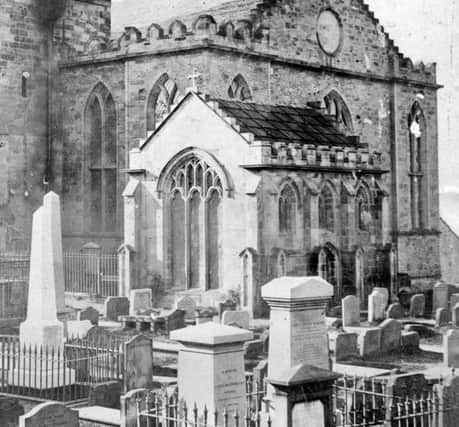The paths of glory lead but to the grave


The Dundas family had made a fortune from the Great Canal between Forth and Clyde in which Lord Thomas’ father, Sir Lawrence Dundas, had been the main shareholder. He had purchased the lands of West Kerse in 1752 and along with them came the right to bury the family dead at the east end of the church. Thus the new building included a large mausoleum on that same spot which is known today as the Zetland Tomb from the name adopted by the family when they were created earls in 1838. Today it contains just three burials Sir Lawrence Dundas, his wife and Lord Thomas himself. The other seven places remain empty and succeeding family members are buried in North Yorkshire where the wealthy earls settled in the Victorian era.
The Forbes family did not enjoy the same inherited rights of burial. The old owners of Callendar, the Livingstons, lay to the south of the church but the incomers had to seek another place to honour their dynasty and like, the Dundas family, they had no shortage of cash to do it. William Forbes had made his fortune selling copper to the navy and in 1783 used it to buy Callendar Estate becoming the second biggest landowner in Stirlingshire and the most powerful man in the Falkirk district. No decision, religious, educational, industrial or agricultural, was free from his influence and he helped make the Falkirk we know today.
Advertisement
Hide AdAdvertisement
Hide AdWhen he died in 1815 his family commissioned Archibald Elliot to design the mausoleum which stands about 800 yards south-east of Callendar House. It is in the form of a Greek style temple set on a ‘drum podium’ with twelve fluted Doric columns and a domed roof. Above the door is a verse from the Greek poet Lucian which roughly translates as ‘possesions are mortal and all things pass us by”. William and, later, his son and heir were laid to rest there and a small graveyard was established in the surrounding enclosure where other family members and servants were buried. Today the building is a sorry sight, disfigured by graffiti, while the enclosure is strewn with rubbish, broken stones and the remnants of grave markers.
One pathetic message half buried in the earth reminds us of “Caroline McCallum, for 26 years a faithful nurse”. Another stone fragment marks the burial place of the powerful third William Forbes who died in 1914 aged 81 and who missed out on a place in the mausoleum. His huge funeral attracted all the ‘great and good’ of the district. It is a sad reminder of Thomas Grey’s famous lines: “The boast of heraldry, the pomp of power; and all that beauty, all that wealth ere gave. Awaits alike the inevitable hour – the paths of glory lead but to the grave.”